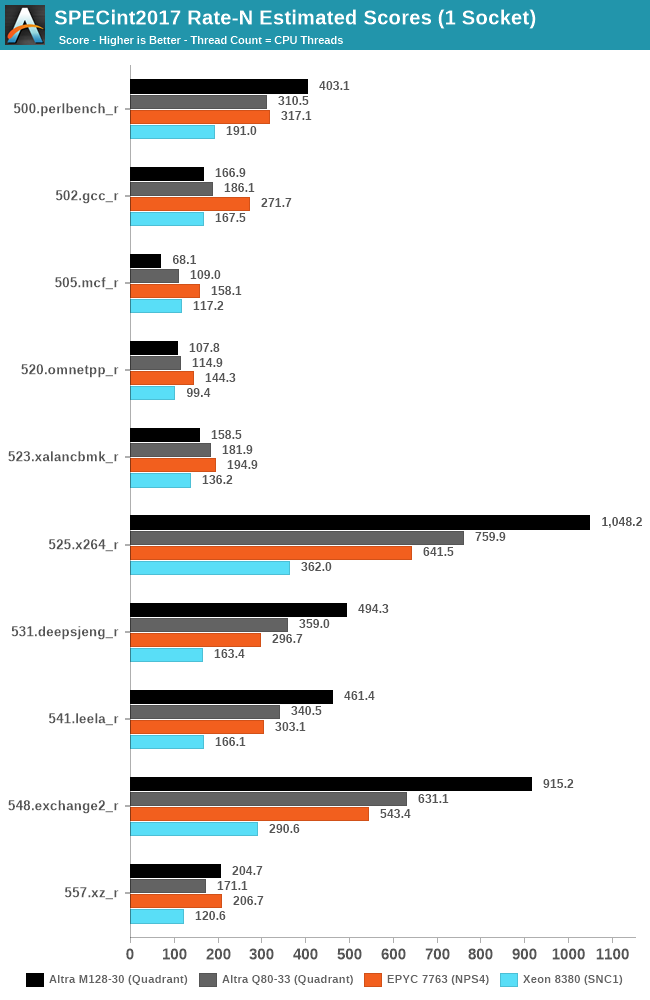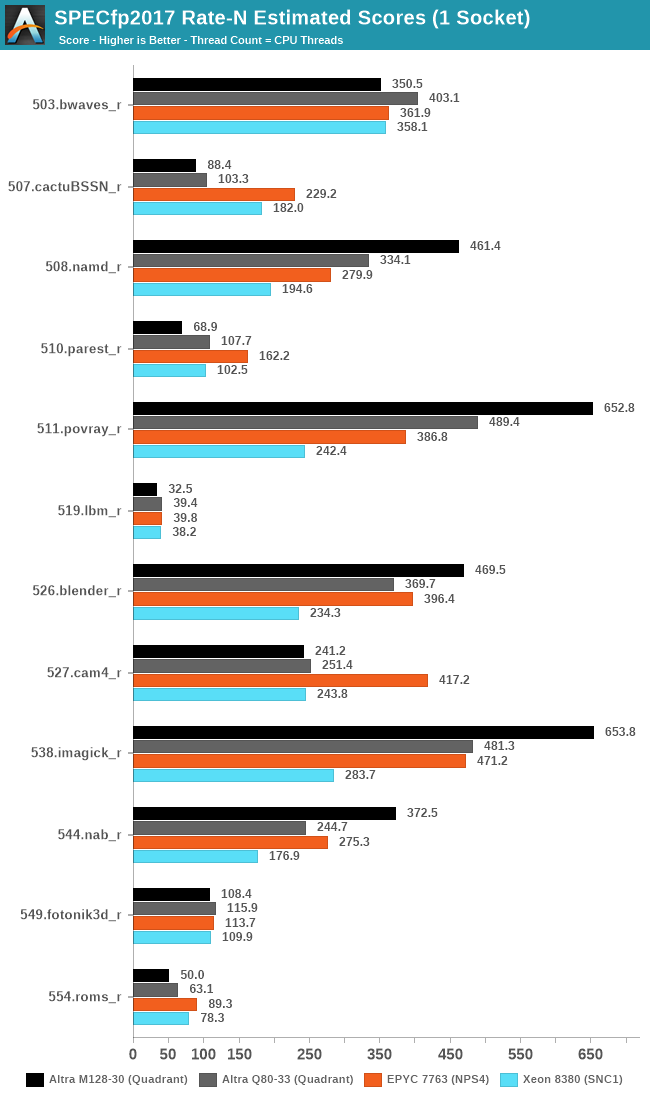The Ampere Altra Max Review: Pushing it to 128 Cores per Socket
by Andrei Frumusanu on October 7, 2021 8:00 AM EST- Posted in
- Servers
- Arm
- Neoverse N1
- Ampere
- Altra Max
SPEC - Multi-Threaded Performance - Subscores
We’re starting off with the multi-threaded/process SPEC CPU rate results. As usual, because there are not officially submitted scores to SPEC, we’re labelling the results as “estimates” as per the SPEC rules and license.
We compile the binaries with GCC 10.2 on their respective platforms, with simple -Ofast optimisation flags and relevant architecture and machine tuning flags (-march/-mtune=Neoverse-n1 ; -march/-mtune=skylake-avx512 ; -march/-mtune=znver2).
We’re focusing our comparisons between the new M128-30, the previous Q80-33, and AMD’s flagship EPYC 7763 and Intel’s new Xeon 8380. The Altra chips are running at 250W TDPs at respectively 128/80 cores, the EPYC at 280W and 64 cores, and the Xeon at 270W for 40 cores. The SMT systems have it enabled, and we’re running peak threads in these subscores.

In SPECint2017, we’re seeing two different result-sets for the new Altra Max system – either very large gains, or some more notable performance regressions.
Workloads such as 525.x264_r, 531.deepsjeng_r, 541.leela_r, and 548.exchange2_r, have one large commonality about them, and that is that they’re not very memory bandwidth hungry, and are able to keep most of their working sets within the caches. For the Altra Max, this means that it’s seeing performance increases from 38% to 45% - massive upgrades compared to the already impressive Q80-33.
The 45% increase in 548.exchange2_r is essentially almost perfect linear scaling with the core count and frequencies; although the M128-30 has 60% more cores, it’s also running at 10% lower frequencies, so 45% more theoretical throughput.
523.xlancbmk_r also isn’t very DRAM traffic heavy in traditional systems, however it has a larger working set than the other aforementioned workloads, and the smaller SLC size and increased core count don’t do it favours as it becomes resource contended. The same can be said of 502.gcc_r, which is also slower than the Q80-33.
505.mcf_r is the worst-case scenario, although memory latency sensitive, it also has somewhat higher bandwidth that can saturate a system at higher instance count, and adding cores here, due to the bandwidth curve of the system, has a negative impact on performance as the memory subsystem becomes more and more inefficient. The same workload with only 32 or 64 instances scores 83.71 or 101.82 respectively, much higher than what we’re seeing with 128 cores.

In the FP suite, we’re seeing a same differentiation between the M128-80 and the other systems. In anything that is more stressful on the memory subsystem, the new Mystique chip doesn’t do well at all, and most times regresses over the Q80-33.
In anything that’s simply execution bound, throwing in more execution power at the problem through more cores of course sees massive improvements. In many of these cases, the M128-30 can now claim a rather commanding lead over the competition Milan chip, and leaving even Intel’s new Ice Lake-SP in the dust due to the sheer core count and efficiency advantage.










60 Comments
View All Comments
Jurgen B - Thursday, October 7, 2021 - link
Love your thorough article and testing. This is some serious firing power from the Ampere and makes some great competition for Intel and AMD. I really like the 256T runs on the AMD Dual socket EPYCs (they really are serving me well in floating point research computing), but it seems that future holds some nice innovations in the field!mode_13h - Thursday, October 7, 2021 - link
Lack of cache seems to be a serious liability, though. For many, it'll be a deal breaker.Wilco1 - Friday, October 8, 2021 - link
Yet it still beats AMD's 7763 with its humongous 256MB L3 in all the multithreaded benchmarks. Sure, it would be even faster if it had a 64MB L3 cache, however it doesn't appear to be a serious liability. Doing more with far less silicon at a lower price (and power) is an interesting design point (and apparently one that cloud companies asked for).Jurgen B - Friday, October 8, 2021 - link
Yes, Cache will play a role for many. However, people buying such servers likely have a very specific workload in mind. And thus they now have more choices which of the manufacturer options they prefer, and these choices are really good to see. Compared to 10 years ago, when AMD was much less competitive, it is wonderful to see the innovation.schujj07 - Friday, October 8, 2021 - link
That isn't true at all. The SPEC java benchmarks have the Epyc ahead, SpecINT Base Rate-N Estimated they are almost equal (despite having half the cores), FP Base Rate-N Estimated the Epyc is ahead, compiling the Epyc is ahead. Anything that will tax the memory subsystem by not fitting into the small cache of the Altra and the performance is lower for the Altera. Per core performance isn't even close.mode_13h - Saturday, October 9, 2021 - link
Thanks for correcting the record, @schujj07.The whole concept of adding 60% more cores while halving cache is mighty suspicious. In the most charitable view, this is intended to micro-target specific applications with low memory bandwidth requirements. From a more cynical perspective, it's merely an exercise in specsmanship and maybe trying to gin up a few specific benchmark numbers.
Wilco1 - Saturday, October 9, 2021 - link
If you're that cynical one could equally claim that adding *more* cache is mighty suspicious and gaming benchmark numbers. Obviously nobody would spend a few hundred million on a chip just to game benchmarks. The fact is there is a market for chips with lots of cores. Half the SPEC subtests show huge gains from 60% extra cores despite the lower frequency and halved L3. So clearly there are lots of applications that benefit from more cores and don't need a huge L3.Wilco1 - Saturday, October 9, 2021 - link
The Altra Max wins the more useful critical-jOPS benchmark by over 30%. It also wins the LLVM compile test and SPECINT_rate by a few percent. The 7763 only wins SPECFP by 18% (not Altra's market) and max-jOPS by 13%.So yes my point is spot on, the small cache does not look at all like a serious liability. Per-core performance isn't interesting when comparing a huge SMT core with a tiny non-SMT core - you can simply double the number of cores to make up for SMT and still use half the area...
mode_13h - Saturday, October 9, 2021 - link
> Per-core performance isn't interesting when comparing ...Trying to change the subject? We didn't mention that. We were talking only about cache.
> The Altra Max wins the more useful critical-jOPS benchmark by over 30%.
That's really about QoS, which is a different story. Surely, relevant for some. I wonder if x86 CPUs would do better on that front with SMT disabled.
> the small cache does not look at all like a serious liability.
Of course it's a liability! It's just a very workload-dependent one. You need only note the cases where Max significantly underperforms, relative to its 80-core sibling, to see where the cache reduction is likely an issue.
The reason why there are so many different benchmarks is that you can't just seize on the aggregate numbers to tell the whole story.
mode_13h - Saturday, October 9, 2021 - link
Apologies, I now see where schujj07 mentioned per-core performance. I even searched for "per-core" but not "per core".